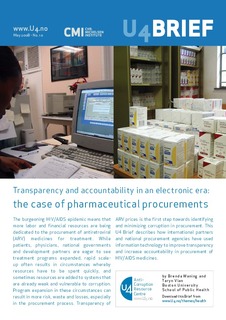| dc.contributor.author | Waning, Brenda | |
| dc.contributor.author | Vian, Taryn | |
| dc.date.accessioned | 2018-01-04T08:15:52Z | |
| dc.date.available | 2018-01-04T08:15:52Z | |
| dc.date.issued | 2008-05-02 | |
| dc.identifier | oai:www.cmi.no:3030 | |
| dc.identifier.citation | Bergen: Chr. Michelsen Institute (U4 Brief 2008:10) 4 p. | |
| dc.identifier.uri | http://hdl.handle.net/11250/2474551 | |
| dc.description.abstract | The burgeoning HIV/AIDS epidemic means that more labor and financial resources are being dedicated to the procurement of antiretroviral (ARV) medicines for reatment. While patients, physicians, national governments and development partners are eager to see treatment programs expanded, rapid scaleup often results in circumstances whereby resources have to be spent quickly, and sometimes resources are added to systems that are already weak and vulnerable to corruption. Program expansion in these circumstances can result in more risk, waste and losses, especially in the procurement process. Transparency of ARV prices is the first step towards identifying and minimizing corruption in procurement. This U4 Brief describes how international partners and national procurement agencies have used information technology to improve transparency and increase accountability in procurement of HIV/AIDS medicines. | |
| dc.language.iso | eng | |
| dc.publisher | Chr. Michelsen Institute | |
| dc.relation | U4 Brief | |
| dc.relation | 2008:10 | |
| dc.relation.ispartof | U4 Brief | |
| dc.relation.ispartofseries | U4 Brief 2008:10 | |
| dc.relation.uri | https://www.cmi.no/publications/3030-transparency-and-accountability-in-an-electronic | |
| dc.subject | Corruption | |
| dc.subject | Health Sector | |
| dc.title | Transparency and Accountability in an Electronic Era: The Case of Pharmaceutical Procurements | |
| dc.type | Report | |
